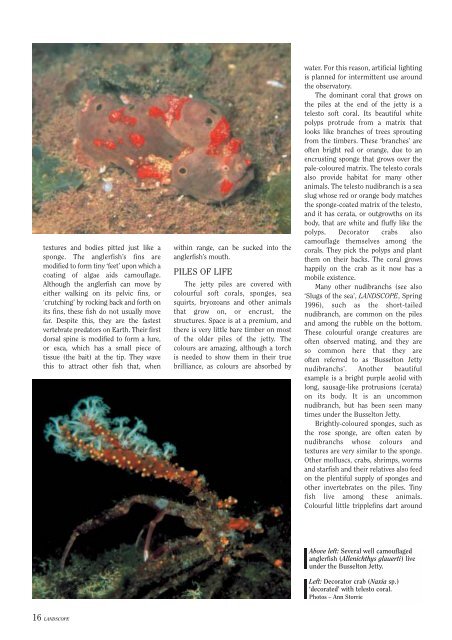Under Busselton Jetty - Department of Environment and Conservation
Under Busselton Jetty - Department of Environment and Conservation
Under Busselton Jetty - Department of Environment and Conservation
Create successful ePaper yourself
Turn your PDF publications into a flip-book with our unique Google optimized e-Paper software.
textures <strong>and</strong> bodies pitted just like a<br />
sponge. The anglerfish’s fins are<br />
modified to form tiny ‘feet’ upon which a<br />
coating <strong>of</strong> algae aids camouflage.<br />
Although the anglerfish can move by<br />
either walking on its pelvic fins, or<br />
‘crutching’ by rocking back <strong>and</strong> forth on<br />
its fins, these fish do not usually move<br />
far. Despite this, they are the fastest<br />
vertebrate predators on Earth. Their first<br />
dorsal spine is modified to form a lure,<br />
or esca, which has a small piece <strong>of</strong><br />
tissue (the bait) at the tip. They wave<br />
this to attract other fish that, when<br />
within range, can be sucked into the<br />
anglerfish’s mouth.<br />
PILES OF LIFE<br />
The jetty piles are covered with<br />
colourful s<strong>of</strong>t corals, sponges, sea<br />
squirts, bryozoans <strong>and</strong> other animals<br />
that grow on, or encrust, the<br />
structures. Space is at a premium, <strong>and</strong><br />
there is very little bare timber on most<br />
<strong>of</strong> the older piles <strong>of</strong> the jetty. The<br />
colours are amazing, although a torch<br />
is needed to show them in their true<br />
brilliance, as colours are absorbed by<br />
water. For this reason, artificial lighting<br />
is planned for intermittent use around<br />
the observatory.<br />
The dominant coral that grows on<br />
the piles at the end <strong>of</strong> the jetty is a<br />
telesto s<strong>of</strong>t coral. Its beautiful white<br />
polyps protrude from a matrix that<br />
looks like branches <strong>of</strong> trees sprouting<br />
from the timbers. These ‘branches’ are<br />
<strong>of</strong>ten bright red or orange, due to an<br />
encrusting sponge that grows over the<br />
pale-coloured matrix. The telesto corals<br />
also provide habitat for many other<br />
animals. The telesto nudibranch is a sea<br />
slug whose red or orange body matches<br />
the sponge-coated matrix <strong>of</strong> the telesto,<br />
<strong>and</strong> it has cerata, or outgrowths on its<br />
body, that are white <strong>and</strong> fluffy like the<br />
polyps. Decorator crabs also<br />
camouflage themselves among the<br />
corals. They pick the polyps <strong>and</strong> plant<br />
them on their backs. The coral grows<br />
happily on the crab as it now has a<br />
mobile existence.<br />
Many other nudibranchs (see also<br />
‘Slugs <strong>of</strong> the sea’, LANDSCOPE, Spring<br />
1996), such as the short-tailed<br />
nudibranch, are common on the piles<br />
<strong>and</strong> among the rubble on the bottom.<br />
These colourful orange creatures are<br />
<strong>of</strong>ten observed mating, <strong>and</strong> they are<br />
so common here that they are<br />
<strong>of</strong>ten referred to as ‘<strong>Busselton</strong> <strong>Jetty</strong><br />
nudibranchs’. Another beautiful<br />
example is a bright purple aeolid with<br />
long, sausage-like protrusions (cerata)<br />
on its body. It is an uncommon<br />
nudibranch, but has been seen many<br />
times under the <strong>Busselton</strong> <strong>Jetty</strong>.<br />
Brightly-coloured sponges, such as<br />
the rose sponge, are <strong>of</strong>ten eaten by<br />
nudibranchs whose colours <strong>and</strong><br />
textures are very similar to the sponge.<br />
Other molluscs, crabs, shrimps, worms<br />
<strong>and</strong> starfish <strong>and</strong> their relatives also feed<br />
on the plentiful supply <strong>of</strong> sponges <strong>and</strong><br />
other invertebrates on the piles. Tiny<br />
fish live among these animals.<br />
Colourful little tripplefins dart around<br />
Above left: Several well camouflaged<br />
anglerfish (Allenichthys glauerti) live<br />
under the <strong>Busselton</strong> <strong>Jetty</strong>.<br />
Left: Decorator crab (Naxia sp.)<br />
‘decorated’ with telesto coral.<br />
Photos – Ann Storrie<br />
16 LANDSCOPE

















